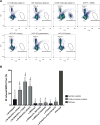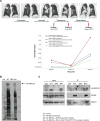Diverse BRCA1 and BRCA2 Reversion Mutations in Circulating Cell-Free DNA of Therapy-Resistant Breast or Ovarian Cancer
- PMID: 28765325
- PMCID: PMC5728372
- DOI: 10.1158/1078-0432.CCR-17-0544
Diverse BRCA1 and BRCA2 Reversion Mutations in Circulating Cell-Free DNA of Therapy-Resistant Breast or Ovarian Cancer
Abstract
Purpose: Resistance to platinum-based chemotherapy or PARP inhibition in germline BRCA1 or BRCA2 mutation carriers may occur through somatic reversion mutations or intragenic deletions that restore BRCA1 or BRCA2 function. We assessed whether BRCA1/2 reversion mutations could be identified in circulating cell-free DNA (cfDNA) of patients with ovarian or breast cancer previously treated with platinum and/or PARP inhibitors.Experimental Design: cfDNA from 24 prospectively accrued patients with germline BRCA1 or BRCA2 mutations, including 19 patients with platinum-resistant/refractory ovarian cancer and five patients with platinum and/or PARP inhibitor pretreated metastatic breast cancer, was subjected to massively parallel sequencing targeting all exons of 141 genes and all exons and introns of BRCA1 and BRCA2 Functional studies were performed to assess the impact of the putative BRCA1/2 reversion mutations on BRCA1/2 function.Results: Diverse and often polyclonal putative BRCA1 or BRCA2 reversion mutations were identified in cfDNA from four patients with ovarian cancer (21%) and from two patients with breast cancer (40%). BRCA2 reversion mutations were detected in cfDNA prior to PARP inhibitor treatment in a patient with breast cancer who did not respond to treatment and were enriched in plasma samples after PARP inhibitor therapy. Foci formation and immunoprecipitation assays suggest that a subset of the putative reversion mutations restored BRCA1/2 function.Conclusions: Putative BRCA1/2 reversion mutations can be detected by cfDNA sequencing analysis in patients with ovarian and breast cancer. Our findings warrant further investigation of cfDNA sequencing to identify putative BRCA1/2 reversion mutations and to aid the selection of patients for PARP inhibition therapy. Clin Cancer Res; 23(21); 6708-20. ©2017 AACR.
©2017 American Association for Cancer Research.
Figures




Similar articles
-
Reversion and non-reversion mechanisms of resistance to PARP inhibitor or platinum chemotherapy in BRCA1/2-mutant metastatic breast cancer.Ann Oncol. 2020 May;31(5):590-598. doi: 10.1016/j.annonc.2020.02.008. Epub 2020 Feb 20. Ann Oncol. 2020. PMID: 32245699 Free PMC article.
-
Routine Plasma-Based Genotyping to Comprehensively Detect Germline, Somatic, and Reversion BRCA Mutations among Patients with Advanced Solid Tumors.Clin Cancer Res. 2020 Jun 1;26(11):2546-2555. doi: 10.1158/1078-0432.CCR-19-2933. Epub 2020 Feb 7. Clin Cancer Res. 2020. PMID: 32034076
-
BRCA Reversion Mutations in Circulating Tumor DNA Predict Primary and Acquired Resistance to the PARP Inhibitor Rucaparib in High-Grade Ovarian Carcinoma.Cancer Discov. 2019 Feb;9(2):210-219. doi: 10.1158/2159-8290.CD-18-0715. Epub 2018 Nov 13. Cancer Discov. 2019. PMID: 30425037 Clinical Trial.
-
BRCA1/2 testing: therapeutic implications for breast cancer management.Br J Cancer. 2018 Jul;119(2):141-152. doi: 10.1038/s41416-018-0127-5. Epub 2018 Jun 5. Br J Cancer. 2018. PMID: 29867226 Free PMC article. Review.
-
Chemotherapy for Patients with BRCA1 and BRCA2-Mutated Ovarian Cancer: Same or Different?Am Soc Clin Oncol Educ Book. 2015:114-21. doi: 10.14694/EdBook_AM.2015.35.114. Am Soc Clin Oncol Educ Book. 2015. PMID: 25993149 Review.
Cited by
-
Synthetic Lethality in Cancer Therapeutics: The Next Generation.Cancer Discov. 2021 Jul;11(7):1626-1635. doi: 10.1158/2159-8290.CD-20-1503. Epub 2021 Apr 1. Cancer Discov. 2021. PMID: 33795234 Free PMC article. Review.
-
Integrating PARP Inhibitors in mCRPC Therapy: Current Strategies and Emerging Trends.Cancer Manag Res. 2024 Sep 17;16:1267-1283. doi: 10.2147/CMAR.S411023. eCollection 2024. Cancer Manag Res. 2024. PMID: 39308935 Free PMC article. Review.
-
Molecular mechanism of PARP inhibitor resistance.Oncoscience. 2024 Sep 23;11:69-91. doi: 10.18632/oncoscience.610. eCollection 2024. Oncoscience. 2024. PMID: 39318358 Free PMC article. Review.
-
Mechanism research and treatment progress of NAD pathway related molecules in tumor immune microenvironment.Cancer Cell Int. 2022 Jul 30;22(1):242. doi: 10.1186/s12935-022-02664-1. Cancer Cell Int. 2022. PMID: 35906622 Free PMC article. Review.
-
Circulating tumor cells and cell-free nucleic acids in patients with gynecological malignancies.Virchows Arch. 2018 Oct;473(4):395-403. doi: 10.1007/s00428-018-2447-5. Epub 2018 Aug 25. Virchows Arch. 2018. PMID: 30145616 Review.
References
-
- Gudmundsdottir K, Ashworth A. The roles of BRCA1 and BRCA2 and associated proteins in the maintenance of genomic stability. Oncogene. 2006;25:5864–74. - PubMed
-
- Lord CJ, Ashworth A. BRCAness revisited. Nat Rev Cancer. 2016;16:110–20. - PubMed
-
- Lord CJ, Ashworth A. Mechanisms of resistance to therapies targeting BRCA-mutant cancers. Nat Med. 2013;19:1381–8. - PubMed
-
- Bryant HE, Schultz N, Thomas HD, Parker KM, Flower D, Lopez E, et al. Specific killing of BRCA2-deficient tumours with inhibitors of poly(ADP-ribose) polymerase. Nature. 2005;434:913–7. - PubMed
MeSH terms
Substances
Grants and funding
LinkOut - more resources
Full Text Sources
Other Literature Sources
Medical
Miscellaneous

